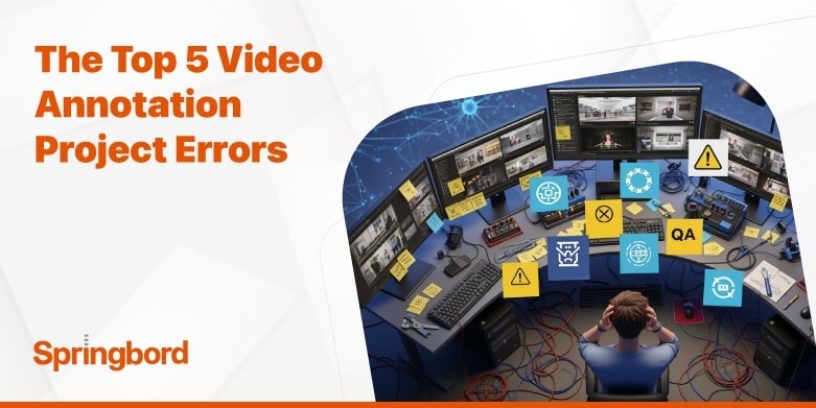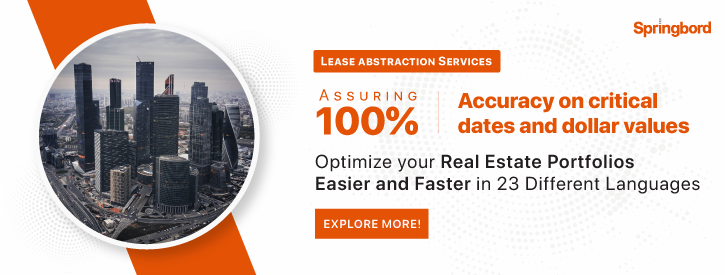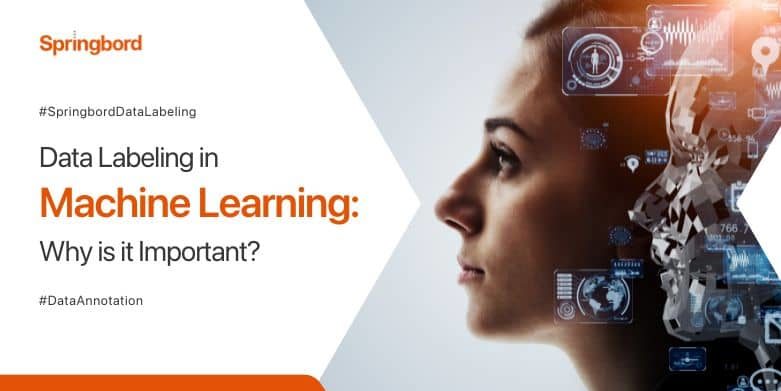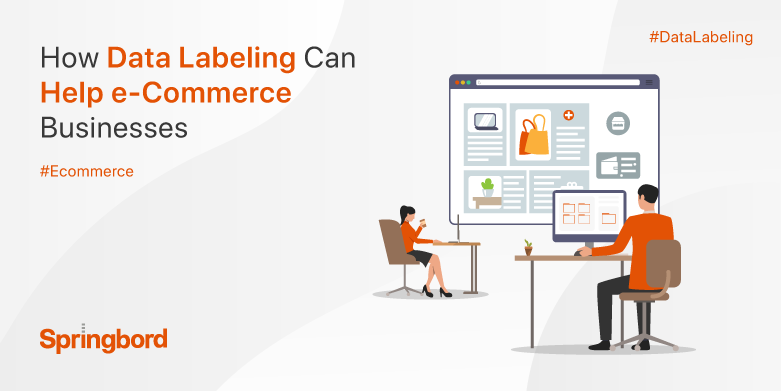 Read time 8 min
Read time 8 minVideo annotation has become a cornerstone of AI-driven applications, powering everything from autonomous vehicles to surveillance and retail analytics. Yet, it’s also one of the most error-prone and resource-intensive stages in the computer vision pipeline.
This is where outsourced data labeling services like ours come in; delivering scalable, high-accuracy video annotation without the overhead of building internal annotation teams.
Too often, businesses approach video annotation as a transactional task, resulting in scalability issues, inconsistent labels, and low model return on investment (ROI). With challenges like temporal consistency, multi-object tracking, and edge-case variability, annotation must be treated as a strategic data engineering workflow, not a simple pre-ML step.
At Springbord, we specialise in managing complex video annotation at scale, blending domain-trained teams, rigorous QA, and tool customization to deliver accurate, production-ready datasets. Our solutions are engineered to support model performance, reduce cycle time, and lower operational risk.
In this blog, we examine the five most common and costly mistakes in video annotation and how to avoid them with a smarter, enterprise-grade strategy.
1. Misaligned Annotation Guidelines with Model Objectives
In many projects, annotation teams label videos based on what’s visible—objects, scenes, or actions—without fully understanding what the machine learning model is supposed to learn. This creates a gap between what is labeled and what the model actually needs. The result? The model suffers from an abundance of superfluous labels, the omission of crucial ones, or the labeling of irrelevant items.
This issue is more common than it seems. A McKinsey study shows that data quality can impact model performance by more than 20%. If the annotation schema isn’t built with the model’s purpose in mind, the data becomes unreliable even if it looks correct.
Why It Hurts Your Business
If the annotations aren’t aligned with the model goals, the training process becomes inefficient. You spend time and money labeling data, but the model doesn’t improve much or, worse, performs poorly. Eventually, you may need to redo large parts of the project, leading to delays and higher costs.
How to Fix It
To avoid this mistake, annotation needs to be closely connected to model design from day one. Here’s what to do:
- Design labels with your ML team – Work together to decide which objects, behaviors, or relationships actually matter to the model.
- Use model feedback – If the model performs poorly, look at the data to see if certain labels are causing problems.
- Update the guidelines as needed – As the model changes or new data appears, the annotation instructions should evolve too.
At Springbord, we collaborate with client data teams to develop intelligent, model-informed annotation standards. By aligning labeling with model needs, we reduce errors, cut rework, and improve accuracy right from the start.
2. Over-Reliance on Generic Tooling
Many teams make the mistake of using general-purpose annotation tools for complex video tasks, tools that were originally built for simple image tagging or object detection. It often involves multi-object tracking, maintaining temporal consistency across frames, and handling 3D sensor data like LiDAR or depth maps.
Generic platforms rarely support features like frame interpolation, cross-frame instance ID linking, or sensor fusion. This lack of flexibility leads to annotation errors and inefficiencies, especially in domains like autonomous driving, smart surveillance, and industrial automation.
Why It Hurts Your Business
Inappropriate tool use slows down teams and adds noise to training data. Datasets may appear complete but lack consistency or time-based relationships critical for video models, hindering scalable annotation and real-world deployment. In production systems, especially with live video, models need precise frame-by-frame labeling. Without it, real-time inference, object tracking, and trajectory learning fail, raising performance risks.
How to Fix It
Outsourcing video annotation to specialized providers not only reduces internal burden but ensures access to domain experts, advanced tools, and streamlined QA pipelines that internal teams often struggle to maintain.
To avoid these pitfalls, businesses need to shift from generic tools to platforms that are tailored to their specific video annotation challenges:
- Choose tools that support temporal annotation, such as interpolation or frame linkage, for video tracking tasks.
- Invest in sensor-aware tooling if your use case involves LiDAR, thermal, or stereo vision data.
- Build or customize interfaces for high-speed labeling, model-in-the-loop correction, or class-specific behavior capture.
At Springbord, we tailor annotation tools to each client’s data, use case, and model pipeline. Whether it’s drone footage or multi-sensor tracking, our teams use advanced platforms to deliver high-accuracy, scalable, and production-ready data.
3. Inadequate Quality Assurance (QA) Pipelines
Quality assurance is often overlooked in many video annotation projects. It’s often done manually, inconsistently, or applied only after large volumes of data have already been labeled. The “check-it-later” approach allows defective annotations, such as missed objects, label drift, or frame misalignment, to silently enter the dataset.
In video annotation specifically, undetected label errors can propagate through hundreds of frames, poisoning your training set and degrading your model’s behavior in production.
Why It Hurts Your Business
Bad labels are worse than missing labels. If annotation errors go unchecked, they can mislead the model into learning incorrect patterns, resulting in low accuracy, unpredictable predictions, or biased decision-making. This type of error is particularly dangerous in high-stakes use cases like autonomous vehicles or surveillance systems, where model failures can carry legal and financial risks.
A flawed QA approach also leads to reannotation costs and extended project timelines, as errors are only caught during model testing or pilot deployment, when it’s often too late or too expensive to fix efficiently.
How to Fix It
Modern video annotation workflows need built-in, real-time quality assurance. Here’s how to do it:
- Automate QA checks wherever possible, flag label inconsistencies, check bounding box overlaps, or track sudden class changes across frames.
- Use confidence scoring at the frame or sequence level so reviewers can quickly identify likely problem areas.
- Adopt dynamic QA sampling, where high-performing annotators are reviewed less frequently, and complex or edge-case data is reviewed more thoroughly.
This type of proactive, data-aware QA process ensures that only clean, meaningful annotations feed into your training pipeline.
At Springbord, we embed multi-level QA into every video annotation project, combining automated checks, reviewer feedback, and smart sampling. Our tailored approach ensures accuracy, consistency, and efficiency, helping clients avoid rework and accelerate model readiness.
4. Neglecting Edge Case Strategy
Edge cases, such as occluded pedestrians, dim lighting, unusual angles, or rare object types, are frequently missed or poorly labeled in video annotation projects. These cases may represent only a small portion of the dataset but can have a disproportionate impact on model behavior, especially in real-world, high-stakes environments.
Most annotation pipelines focus on volume and consistency across common patterns, which often leads to undersampling of edge conditions. But failing to label rare but important scenarios leads to blind spots during model inference. Research by Stanford HAI shows that many AI systems struggle to generalize beyond the distribution of their training data, making edge-case neglect a major barrier to real-world deployment.

Why It Hurts Your Business
When edge cases aren’t handled properly, models become overfitted to “normal” scenarios and break down under unpredictable or less frequent conditions. This can be crucial in sectors like autonomous driving, industrial inspection, or medical imaging, where unhandled edge cases can result in unsafe outcomes or false predictions.
For example, a self-driving system that doesn’t correctly identify partially occluded pedestrians may react too late. In retail analytics, ignoring reflections, shadows, or customer behavior anomalies can skew detection accuracy. These errors undermine trust in your AI systems and can trigger expensive remediation, retraining, or compliance failures.
How to Fix It
Addressing edge cases requires a focused, data-driven strategy:
- Use active learning techniques to prioritize samples where the model is least confident—often these are the edge cases.
- Automine difficult examples from existing video archives using error analysis or prediction uncertainty.
- Label edge cases with extra care and domain expertise, sometimes using specialized tools or workflows.
- Track edge case recall as a separate QA metric to ensure generalization.
By including these difficult instances in training, models become more robust, adaptable, and production-ready.
At Springbord, we treat edge cases as essential, not exceptions. Our teams are trained to label complex scenarios like occlusions and anomalies, using custom workflows and active learning loops to boost dataset diversity. This procedure helps clients build AI that’s resilient and ready for real-world unpredictability.
5. Underestimating Annotation Workforce Training
Many organizations treat data annotation as low-skill labor, assuming that basic instructions are enough for accurate labeling. In reality, effective annotation, especially for video data, requires project-specific knowledge, contextual understanding, and continuous learning. Without structured training, annotators struggle with label ambiguity, inconsistent decisions, and task fatigue.
Such fatigue leads to label drift, where annotation quality degrades over time and slows onboarding for new projects.
Why It Hurts Your Business
Poorly trained teams not only reduce annotation quality but also increase cycle times and the cost of corrections. QA or model testing may not detect inconsistent outputs, leading to costly rework. Worse, as your taxonomy evolves, such as with new object classes, class relationships, or edge case definitions, annotators who aren’t retrained fall out of sync, leading to silent dataset corruption.
This problem scales quickly in enterprise environments where multiple teams or offshore units work on a single video pipeline.
How to Fix It
Annotation should be treated as a skilled, evolving process. To build a workforce capable of delivering consistent, high-quality results,
- Design project-specific onboarding programs, including detailed use cases, model goals, and example scenarios.
- Use decision trees or scenario simulations to train annotators on ambiguous cases before they go live.
- Continuously retrain teams based on feedback, edge case discoveries, or schema updates.
- Track annotator performance and apply targeted refreshers or upskilling when accuracy drops.
This proactive training approach builds annotation teams that are fast, accurate, and adaptable to project evolution.

At Springbord, our annotation workforce is a strategic asset. We train teams with custom modules, simulate edge cases, and continuously upskill through QA feedback and taxonomy updates. The result: faster onboarding, higher throughput, and clean, production-ready data.
Conclusion
Video annotation is no longer a backend task; it’s a mission-critical function that directly shapes the success of AI applications. From aligning annotation schemas with model logic to building quality assurance pipelines and training annotation teams for edge-case resilience, the smallest missteps can snowball into major setbacks.
As AI projects grow in complexity, business leaders must rethink how they approach annotation, not as a cost centre but as a strategic investment in model performance, safety, and scalability.
Outsourced data labeling services like those offered by Springbord empower enterprises to scale efficiently, reduce risks, and achieve faster time-to-model through expert-led, purpose-built annotation workflows.
At Springbord, we combine domain-trained talent, intelligent workflows, and tailored tooling to deliver annotation that goes beyond accuracy; it drives real-world impact.
FAQ
Why is misaligned annotation a problem in video labeling?
If labels don’t match the model’s learning goals, the model performs poorly, leading to wasted time, cost overruns, and potential rework.
Can generic annotation tools be used for video data?
Generic tools often lack features like temporal tracking or sensor fusion, causing errors in complex video annotation tasks.
Why is quality assurance (QA) important in video annotation?
Without proper QA, small labeling mistakes can multiply across frames, reducing model accuracy and increasing the risk of costly rework.
What are outsourced data labeling services?
They involve hiring specialized external teams to annotate data—saving time, reducing costs, and improving quality at scale.
When should a company outsource video annotation?
Outsourcing is ideal when internal resources are limited or when projects require high-volume, expert-level labeling with fast turnaround.
What types of video data can be annotated?
Video annotation can include objects, actions, events, behaviors, and more across domains like retail, autonomous driving, and surveillance.
How does video annotation impact AI model performance?
Accurate, consistent labeling helps models learn better, improving their predictions, safety, and performance in real-world scenarios.






